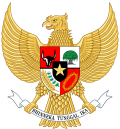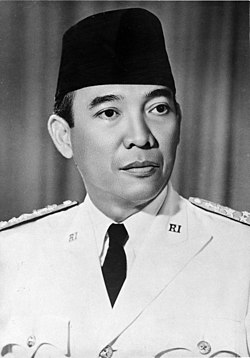Sukarno era
The Indonesian presidency was established during the formulation of the 1945 Constitution by the Investigating Committee for Preparatory Work for Independence (BPUPK). The office was first filled on 18 August 1945, when Sukarno was elected by acclamation by the Preparatory Committee for Indonesian Independence (PPKI) because, according to the Transitional Provisions of the Constitution, "the president and the vice president for the first time shall be elected by the PPKI." Also, the body responsible for the presidential elections, the People's Consultative Assembly (MPR), had not yet been formed. [2] : 138 On 16 October 1945, Vice President Mohammad Hatta announced a vice-presidential decree which gave the Central Indonesian National Committee (KNIP) legislative powers. [2] : 152 On 11 November 1945, the KNIP made the decision to separate the role of head of state from that of head of government. Although a new constitution had not been set up yet, Indonesia was now a de facto parliamentary democracy, with the president as a ceremonial head of state whose function was to ask the prime minister as the head of government to form a new cabinet.
During the Indonesian National Revolution, both Sukarno and Hatta were captured by the Dutch in Yogyakarta on 18 December 1948. Sukarno then gave a mandate for Sjafruddin Prawiranegara to form an emergency government. [3] This was done and the Emergency Government of the Republic of Indonesia (PDRI) was formed in Sumatra with Prawiranegara as its chairman. Prawiranegara handed back his mandate to Sukarno on 13 July 1949. [4] On 17 December 1949, Sukarno was elected president of the United States of Indonesia (RIS), and the presidential mandate passed to Assaat. [5] When the RIS was about to be replaced by a unitary state, Asaat stepped down from the presidency, and Sukarno once again became president on 15 August 1950.
Indonesia now adopted the constitution that had been intended for RIS. Officially known as the Provisional Constitution, the document confirmed the president's role as the head of state, but it limited him to a mostly ceremonial role. He appointed a prime minister on the advice of formateurs. [6]
Despite his limited constitutional role, Sukarno commanded great moral authority. Nonetheless, he was never content with the role of ceremonial head of State, and he grew increasingly disenchanted with western-style parliamentary democracy. In the early 1950s, he began calling for the implementation of "Guided Democracy", in which decisions would be made after lengthy deliberation with a view toward achieving a consensus under presidential "guidance".
The rest of the decade saw a series of unstable governments. Taking advantage of the situation, Sukarno made a speech in April 1959 and suggested that Indonesia return to the 1945 Constitution. [7] The People reacted enthusiastically and there was strong pressure on the Constitutional Assembly, the body responsible for formulating a new constitution, to adopt the 1945 Constitution. When the assembly did not budge, Sukarno issued a presidential decree on 5 July 1959 declaring that Indonesia was returning to the 1945 Constitution. [7] That document made the president head of government as well as head of state. On 18 May 1963, the People's Consultative Assembly elected Sukarno president for life. [8]
Although Indonesia had re-adopted the 1945 Constitution, it did not mean that it was strictly adhered to. MPR, which at this stage was still on a provisional basis (MPRS), was subservient to the president despite its status of the nation's highest governing body. It was only in 1966, when the political tide began to turn against Sukarno that the MPRS nominally regained its rightful constitutional status. In 1967, Sukarno was forced to resign as president, and Army Chief of Staff Suharto was appointed as acting president.
Suharto era
Suharto was elected president in his own right in 1968. During his rise to power, Suharto seemed determined to observe at least the forms of the constitution, and this continued when he became president. Under the constitution, the MPR was responsible for formulating the Outlines of State Policy (GBHN); as president, Suharto was responsible for implementing them. Suharto also made it a presidential obligation to deliver accountability speeches near the end of his terms. During the speech, Suharto outlined the achievements that his administration had made and how those achievements had adhered to the GBHN set by the MPR. Despite the constitutional and democratic façade, Suharto made sure that the MPR was subservient to him. In 1969, a law was passed that required appointments to the MPR to be made official by the president. [9] He also took measures that largely emasculated the opposition parties. For example, he had the power to issue governmental regulations in lieu of law. Nominally, if these regulations were not approved by the House of Representatives (DPR, the pre-2004 legislative branch), they were considered revoked. However, given the DPR's infrequent sessions and the near-total dominance of the pro-government political grouping, Golkar, such approval was a mere formality. Thus, for all intents and purposes, Suharto ruled by decree for most of his tenure. For the better part of Suharto's rule, he effectively held all governing power in the nation.
After Suharto fell from power on 21 May 1998, the presidency experienced changes as a result of the reform movement. Compared to Suharto, who had all of his accountability speeches accepted, B. J. Habibie had his only accountability speech rejected. [10] Abdurrahman Wahid became the first president who had to beat another candidate to be elected, as Sukarno and Suharto had been sole candidates. As a result, Wahid was also the first president to be elected through counting votes instead of by acclamation. However, Wahid was impeached and removed from office by the MPR. This was a clear sign that while the presidency is the key institution, the MPR was now a check on the president's power. Wahid was replaced by his vice-president, Megawati Sukarnoputri, daughter of Sukarno and former opposition leader during Suharto's presidency. [11]
During the 2001 MPR Annual Session, the constitution was amended to provide for the direct election of the president beginning with 2004. [12] In response to Sukarno and Suharto's abuses of power, other amendments passed at that session hedged the presidency about with numerous checks and balances to prevent another president from completely dominating the system. For example, the president was limited to two terms, whether successive or separated. They also lost the right to legislate, but could propose legislation. In the 2004 Indonesian presidential election, Susilo Bambang Yudhoyono became Indonesia's first directly-elected president, beating incumbent Megawati Sukarnoputri in the run-off election. He was re-elected in 2009. In 2014, Yudhoyono finished his second presidential term and was barred from seeking re-election.
The 2014 Indonesian presidential election was held on 9 July 2014 and matched former general and Suharto's ex-son in law Prabowo Subianto against the governor of Jakarta, Joko Widodo. On 22 July, the General Elections Commission announced Joko Widodo's victory. He and his vice-president, Jusuf Kalla, were sworn in on 20 October for a five-year term.







